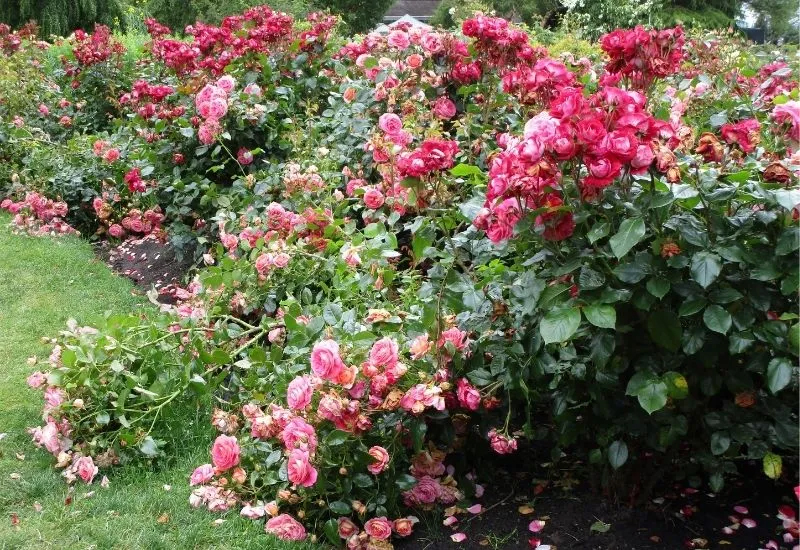Crafting a stunning rose garden isn’t just about luck – it’s also about knowing when and how to prune. Pruning is a key process helping you maintain a gorgeous rose garden beyond watering your roses.
To help you get started, this guide dives into the essential art of rose pruning. Exploring the best and worst times to prune your roses with a step-by-step outline of the process.
Rose bush maintenance and care requires labor beyond watering and fertilizing. Pruning is a crucial step promoting the health of your roses, enhancing their natural beauty, and encouraging new growth.
Pruning prevents plant diseases, identifies diseased growth, and removes parts of the rose bush lacking healthy growth. By properly pruning, you encourage healthy flowering and keep your rose bush full and bountiful.
Pruning roses may seem like a daunting task, but with the right approach, it can be a rewarding process. Follow these steps to ensure a successful pruning session:
Get ready for pruning by making sure you have some essential tools on hand. At a minimum, you’ll need sharp pruning shears and a pair of gardening gloves to protect your hands from thorns. For thicker canes, a pruning saw may be necessary.
Look closely at your rose bush for any stems that have fungal diseases or damages. To tell the difference between the two, dead wood discolors and splits. While diseased branches show spots of odd growths around the base of the plant. Using your pruning shears, make clean cuts at 45-degree angles about 1/4 inch above healthy outward-facing buds.
If a stem is diseased, remove it entirely and dispose of the cuttings to prevent contamination.
Focus on shaping your rose bush to encourage an open and well-structured form. For example, try to identify and prune any branches crossing or crowding other branches to maintain an organized framework. Aim for a balanced, roughly symmetrical shape that allows sunlight to reach all parts of the plant.
Look for older, less productive canes in the center of the rose plant that may hinder new growth. Remove them at the base with a pair of sharp pruning shears. Doing so helps to rejuvenate the rose bush by directing energy to younger canes.
Consider the ideal size and form for the type of rose bush you have.
After pruning, gather all cuttings and dispose of the material away from rose beds minimizing the risk of disease.
Pruning your roses at the right time of the year is key for their well-being. The ideal timing varies depending on the type of roses you’re growing. Here’s the rule of thumb for the most common types of roses:

Hybrid tea roses and floribundas generally benefit from thorough pruning in late winter or early spring. Remove dead or weak canes and shape the plant to encourage airflow and prevent spread of disease when pruning.
Climbing roses often bloom on the previous year’s growth. Meaning, the best time to prune them is late winter or early spring before new growth begins. This time frame allows you to shape the plant and remove any dead or weak canes while preserving the potential for flourishing blooms.

Known for their hardiness and continuous blooms, Knockout roses benefit from a different pruning schedule than other rose types. Late winter or early spring is suitable for shaping, but light trimming during the growing season encourages consistent flowering.
Timing is everything when pruning roses and if you aren’t careful, you might miss the window of opportunity. It’s essential to avoid adverse effects on your plants.
Waiting until late spring or summer to prune your rose causes delayed production and less flowers. Additionally, your plant could wilt or die if you prune during this period. Pruning too early harms the plant by stimulating new growth too soon especially when the plant is still vulnerable to the season’s cold weather. Avoid pruning roses within four to six weeks of the last frost in your area.
Here are a few final pieces of advice for successful rose pruning this year:
Strong winds can cause damage to your rose bushes and require prompt pruning to mitigate this damage. If there have been strong winds in your area, inspect your rose bushes for damage as soon as possible. Prune away broken branches or disrupted growth to maintain the plant’s structure and promote a healthy bloom.
Fertilizing is key to stimulating new growth for your roses. After each pruning, fertilize your bushes with a balanced fertilizer. Fertilizer gives the plant essential nutrients needing to grow healthily and increase the chances of a flourishing bloom. Be sure to follow the user instruction for optimal application rates.
Typically, summer pruning tends to be an inopportune time for major pruning. You can perform light pruning in the summer to remove dead flower heads and shape the plant as needed. This process will maintain the roses’ integrity and structure for a beautiful appearance year-round.
Consider pruning the roses right after the first flush of flowers. This process encourages a repeat blooming cycle for your roses, perfect for ongoing growth and flourishing, vibrant bushes.
Here are answers to some crucial questions you might have during the pruning process:
One of the benefits of pruning is the frequency – most gardeners only have to prune once per year during late winter or early spring. Depending on the condition of your rose bushes, you can conduct a lighter pruning before winter.
The issue is likely to do with over-pruning. Beyond avoiding over-pruning, you can consider the following steps if your roses don’t flower after pruning: